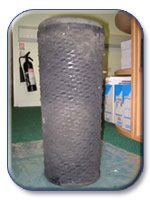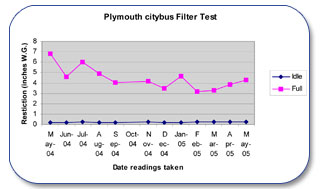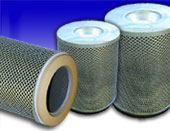Plymouth
Citybus Long Life Polyurethane Filter Test
Report
Date:
31st May 2005
Conducted
and produced by: Darran Johnson –
Product Director
Scope
To evaluate a Series 5 filter, so as to achieve a service
period of one year for normal service schedules.
Readings were taken every month to ensure that there
were no problems with restriction during the operating
year through summer and winter conditions over the one-year
period.
Examination of the filter was to be carried out when
each reading had been taken and to show and discuss
with the engineering staff, as to how the contaminants
load onto and into the filter, so that the filters would
not be prematurely discarded based on only a visual
inspection.
Test Procedure
Plymouth Citybus chose a suitable vehicle i.e. Dennis
Dart Euro 2, where a Series 5 filter was fitted into
the existing housing. A reading was taken using a digital
manometer and logged, along with vehicle mileage, so
that a chart of restriction over the time period could
be produced. The manometer was attached to the 1/8th
BSP male pipefitting that the canister restriction indicator
would normally be attached to.
Results
 The
filter was returned to Series 5 for evaluation.
The
filter was returned to Series 5 for evaluation.
On a quick initial inspection the filter looked dirty,
with approximately 30% of the outer surface of the filter
plated with contaminants. This normally has the effect
of most engineering staff, changing the filter without
looking more closely at the filter structure below the
outer support cage. A reticulated polyurethane media
filter not only relies partly on surface area for filtration
capacity but also the depth of the media to achieve
its long life capabilities.
The two close-up pictures below show the difference
in contaminant loading from a virtually uncontaminated
pore structure to that of a fully loaded contaminated
structure.
It
is worth remembering that the dirt sticks to the strands
of the polyurethane structure and not the particles
blocking the pores of the polyurethane.
|
|
polyurethane
Structure – minimal contaminant |
polyurethane
Structure – maximum contaminant |
The strand thickening by the contaminants can be seen
in both of the close – up pictures and then it
reaches a point where both strands will meet and block
the pore.
Listed below are the readings that were taken by myself
along with Alan Gavin on my monthly visits to your depot,
noting the mileage of the vehicle for a guideline as
well as time period.
| Vehicle
No.25 |
|
| Date |
Idle |
Full |
Mileage |
Mileage
covered (km) |
| May
12, 2004 |
0.21 |
6.83 |
528387 |
|
| June
16, 2004 |
0.21 |
4.58 |
535720 |
7333 |
| July
27, 2004 |
0.25 |
6.04 |
545545 |
17158 |
| August
25, 2004 |
0.21 |
4.9 |
553429 |
25042 |
| September
28, 2004 |
0.21 |
4.02 |
563162 |
34775 |
| November
8, 2004 |
0.26 |
4.16 |
573039 |
44652 |
| December
6, 2004 |
0.19 |
3.49 |
578473 |
50086 |
| January
12, 2005 |
0.21 |
4.63 |
584902 |
56515 |
| February
14, 2005 |
0.22 |
3.14 |
591177 |
62790 |
| March
17, 2005 |
0.22 |
3.27 |
597849 |
69462 |
| April
20, 2005 |
0.23 |
3.86 |
606411 |
78024 |
| May
19, 2005 |
0.24 |
4.27 |
612129 |
83742 |

Conclusion
A reduction in restriction was noted during the first
9 months of the test followed by an increase, which
would continue through to the end of the full life capacity
of the filter. This is normal due to the fact that as
the dirt loads onto the polyurethane strands, the aerodynamic
effect of the airflow through the filter improves.
There is also a spike in restriction on the January
reading and this was due to it being a very wet day,
which will reduce as the filter dries out.
As the filter media is a composites of plastic, the
filter integrity is unaffected with water being offered
to the filter and no loss of filtration specifications
will be had when the filter dries out. There will be
no premature failures due to Hydrocarbon intake, as
the depth properties of the filter media, have the ability
to absorb these compounds with no increase in restriction.
The
filter has comfortably achieved the “one-year
service life” with a large safety margin for unexpected
high contaminant levels or heavy water ingress from
the environment or bus wash.
I can therefore recommend that changing over to our
“Series 5” range of filters will eliminate
any premature filter failures, while giving a cost reduction
due to the number and frequency of filter changes being
considerably reduced.
Next
>>










